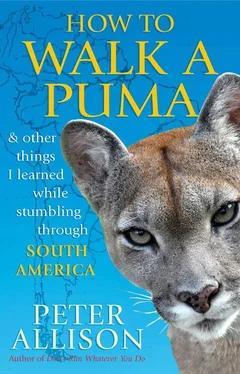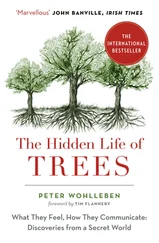Whereas Africa always appears brown in documentaries, every nature show I’d ever watched about South America has been in glorious technicolour. Evolution seems to have taken some strange, strong medicine before setting to work there, producing improbable, extraordinary creatures. In Africa I could be trampled by elephants or consumed by lions; the most dangerous animal in South America is a kaleidoscopic frog so toxic that just touching it can be lethal. There is a bird called the hoatzin which has evolved my favourite strategy for evading the attention of predators, a solution so simple that anything else seems a waste of energy—it is too smelly to eat. Then there are sloths, whose legendary slowness actually works for them, making them hard to pick out among the foliage in which they live—this, along with a groove in each of their hairs in which camouflaging algae grows, makes them almost invisible. I wanted to see all these animals and more; but above all, more than any bird, fish or reptile, I wanted to fulfil an ambition born of all those nature documentaries I’d watched as a child: to see a wild jaguar.
But my plans are usually only good for one thing—laughing at in hindsight—so, armed with bad Spanish, coupled with dangerous levels of curiosity and a record of poor judgement, I set off to tackle whatever South America could throw at me.
Running with Roy

‘See a jaguar? Mwah ha ha! You’re more likely to fall pregnant to a llama,’ said my friend Marguerite Gomez as we drove from Santiago airport to her home.
Marguerite’s husband, Harris, gave me an apologetic look at his wife’s bluntness, but as she and I were old friends from Africa days I was far from offended. And I also knew she was right. Jaguars live in the jungle, a hard place to see anything that isn’t right in front of you, given the usually impenetrable foliage. Adding to the challenge, the jaguar is the master of stealth. If they don’t want to be seen, chances are they won’t be.
But if it was going to be easy, why would I bother?
‘I’m going to see one, along with everything else natural that I can,’ I countered.
‘Sure,’ said Marguerite, as you would to someone who’s just told you they have access to Nigeria’s hidden billions.
The birds of South America were another draw for me, as during my safari career I had picked up the hobby of birdwatching, a habit which to some people is as sexy as flatulence (at best when I admit to it I get a restrained smile that clearly indicates the listener wants to hear no more).
I stayed for a week with Marguerite, Harris and their two young daughters. Harris shared with me the delight of staggeringly good Chilean wines while Marguerite mixed the best pisco sour on the continent. (The pisco sour is a wonderful cocktail that both Chile and Peru claim to have invented; at times this argument becomes so heated you wouldn’t be surprised if it led to military action—not as improbable as it sounds considering the countries once waged war over bird poo.)
When I arrived in Santiago I hadn’t expected to see many animals around the city of high rises and office blocks, but on only my second day Marguerite summoned me upstairs, insisting I bring binoculars with me. Through them I saw an enormous bird soaring over the not-so-distant, snow-frosted peaks of the Andes.
‘Condor?’ Marguerite asked, grinning, knowing how much I would enjoy it if it was.
‘Wow,’ was my eloquent reply. That was all it could be; there was nothing else so huge in the skies that wasn’t man-made.
The condor was the bird I’d most wanted to see. The sighting was a great welcome to South America and more than I could have asked for—until I hit somewhere more wild I would have been content with the mockingbirds and hummingbirds that visited the Gomezes’ garden.
Santiago is a city occasionally reviled by travellers seeking the famed chaos and liveliness of South America, but I think this is unfair. While it may lack the exuberance of Buenos Aires and the sexiness of Rio, it has its charms, such as the fancy, brightly coloured buildings jammed beside cheap student bars with plastic chairs and umbrellas advertising beer, sharing a bonhomie until late into every night. Food is excellent in the city, and levels of service high. In short it was the perfect introduction to South America. While I was impressed with Santiago’s orderliness and cleanliness, I was now to set off for Bolivia, a place that Harris said was so undeveloped not even Chileans visited.
‘Good,’ I replied cockily, to hide my own doubts about the decision I’d made in leaving Sydney. Was a nomadic life really feasible? Was I too old for this? Was I, perhaps, now too wise to have the sort of adventures that Africa had given me?
In a life peppered with moments of grand idiocy, the last thought was the most foolish so far.
•
In central Bolivia, in a patch of forest near the small town of Villa Tunari, lives a puma. His russet fur shows that he is a jungle puma (mountain pumas have grey coats), but he wasn’t born there. At the age of around six weeks he was confiscated by wildlife authorities from a marketplace. The wildlife authorities then delivered him to a group called Inti Wara Yassi who take in such animals, care for them as best they can and then release them if possible. This particular puma has noble features, is strongly muscled, and deserves a mighty name. But he is called Roy. And I was tied to him for a month.
I got to know Roy while I was volunteering at Parque Machia, a small reserve where hundreds of animals live and the first stop on my quest to learn about South America’s wilderness. After a flight from Santiago to crumbly old Santa Cruz de la Sierra, one of Bolivia’s larger towns, I’d hopped onto a surprisingly modern bus. Its passengers were mainly locals, with a smattering of backpackers. Among the locals were bowler hat– and poncho-wearing women, a sight that went from captivating to commonplace as we passed through a bewildering series of villages. After a day of travelling I stumbled from the bus halfway between Santa Cruz and Cochabamba into the town of Villa Tunari.
The local mayor runs a small tourist attraction next to the Parque Machia reserve, where visitors—mainly Bolivians—come to see monkeys who are unusually relaxed around humans. The reserve also has bears, ocelots, coatis, macaws, eagles and pumas, but the tourists don’t get to see these unless they meet one as it crosses the trails with its handlers. For the animals’ wellbeing most of them see no one but their handlers.
While Bolivians founded and manage Parque Machia, most of the staff is made up of short-term volunteers from every corner of the globe. The group of volunteers while I was at Inti consisted of a close-knit cluster of Israelis, a handful of French, a few Americans, a disproportionately large number of Australians, one or two Italians and a lone Norwegian. (He was quite thrilled when two Danes arrived, since he could understand them.) We pieced together communication through intersecting languages, and the shared love of animals that had drawn us to this punishment.
Within hours of arriving at Parque Machia, I joined eight other new volunteers to listen to an Australian called Bondy give us a rundown on the park. This was to be our induction, we would learn what animals we would be working with during our time there. We had very different backgrounds and reasons for being there, but we were all excited about the work ahead. ‘My sort of people,’ I thought, and was pleased with my decision to come here, even though ensconced volunteers had already warned me that most days were filled with grimy work. ‘A monkey just spunked on me!’ one woman exclaimed moments after I introduced myself at a communal table. ‘That’s after already being shat and pissed on this week!’ (It probably says a lot about me that I still found her quite attractive.)
Читать дальше













